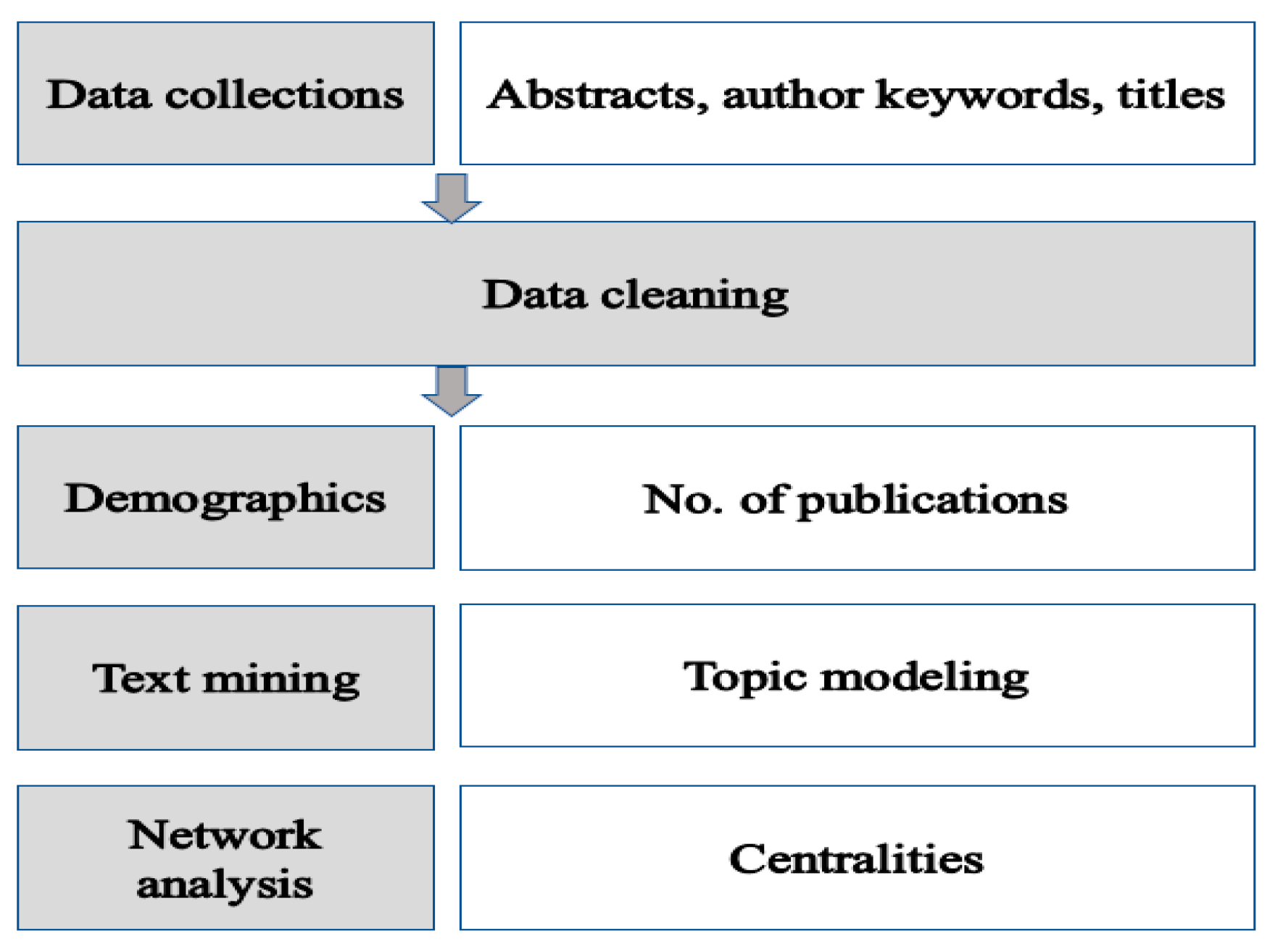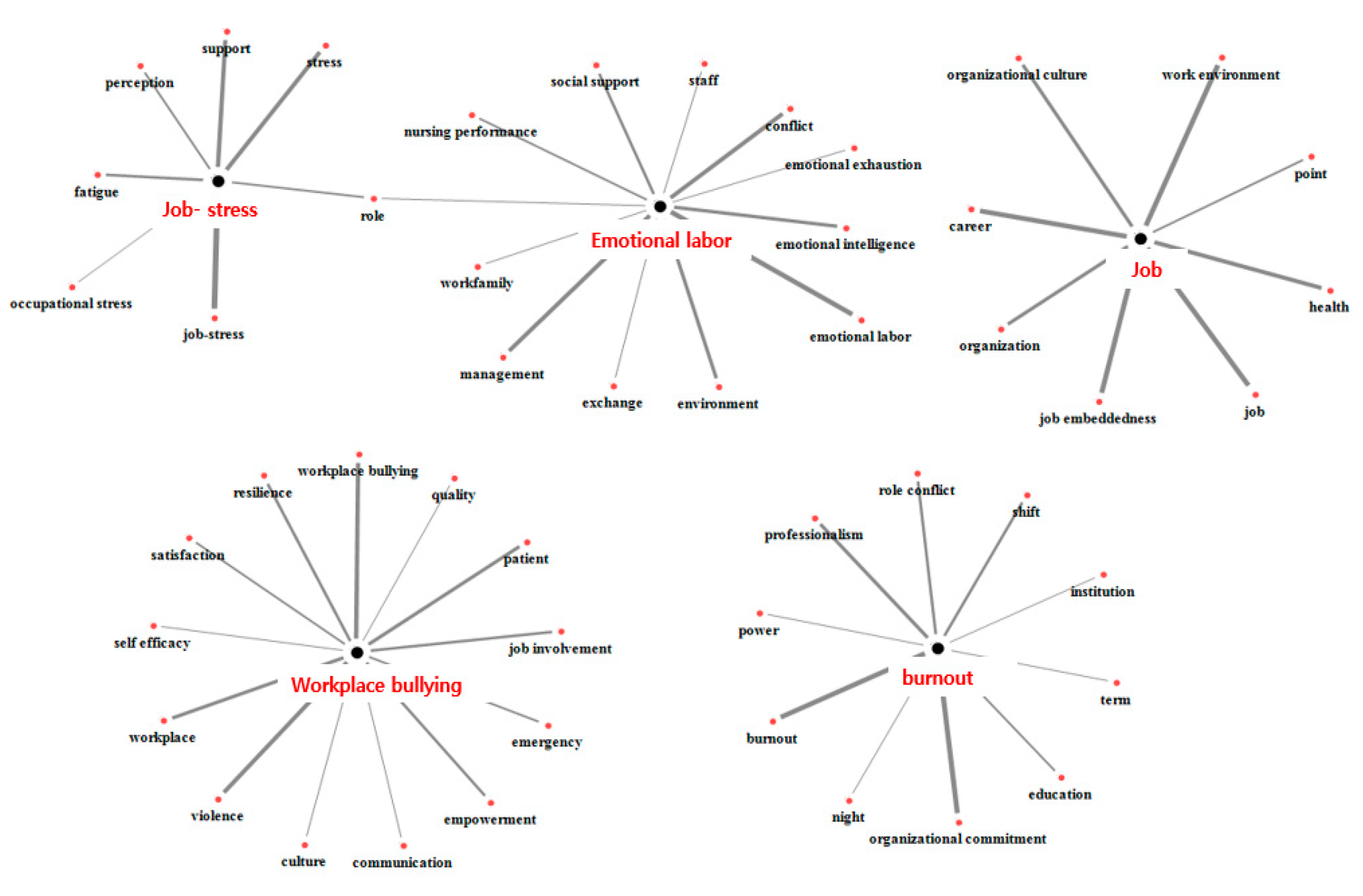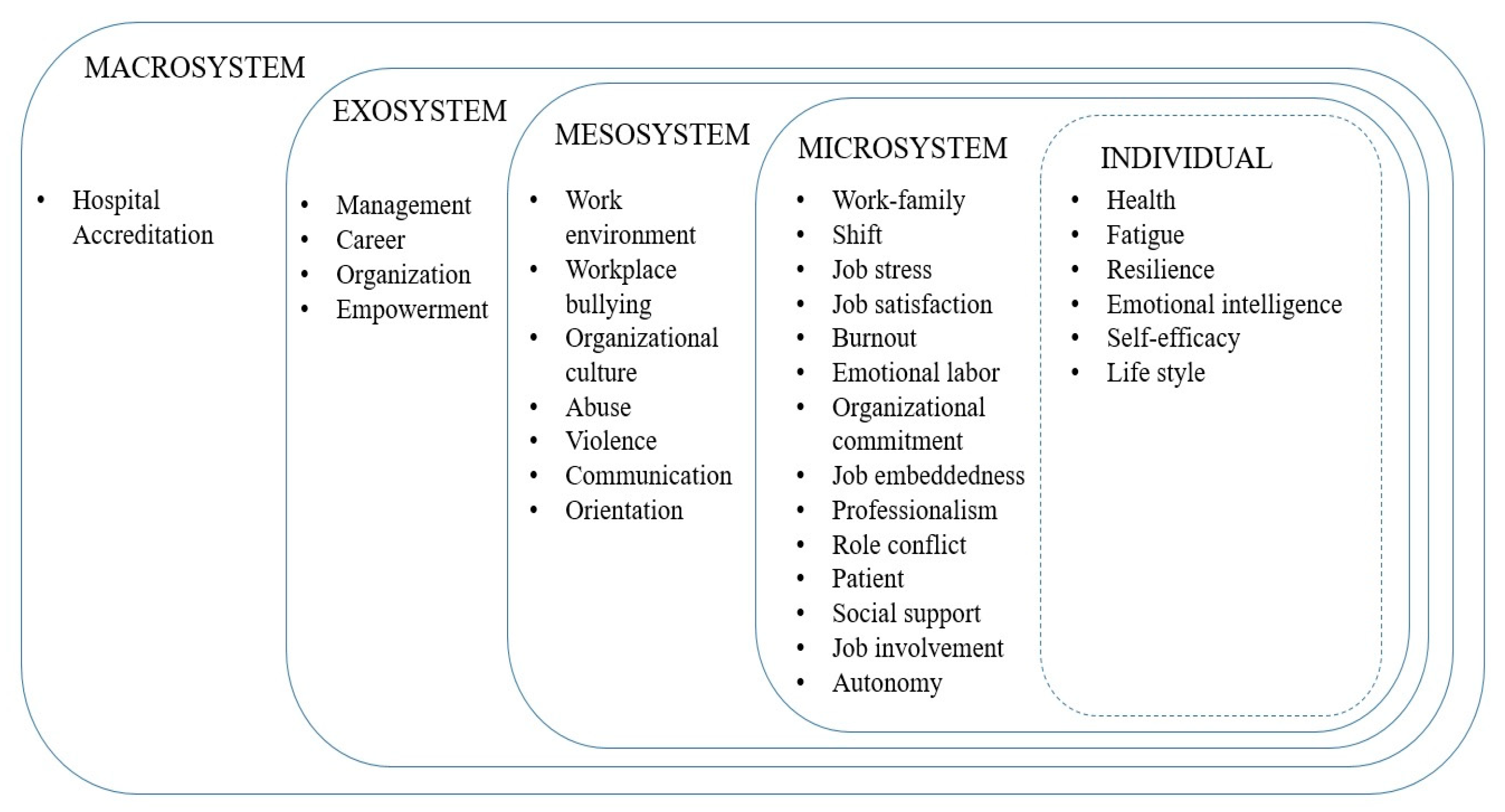Research Topic Trends on Turnover Intention among Korean Registered Nurses: An Analysis Using Topic Modeling
Abstract
1. Introduction
2. Materials and Methods
2.1. Study Design
2.2. Subjects
2.3. Data Collection
2.4. Data Analyses
3. Results
3.1. Publication Trends
3.2. Topic Modeling
3.3. Centrality Analyses
4. Discussion
5. Conclusions
Author Contributions
Funding
Institutional Review Board Statement
Informed Consent Statement
Data Availability Statement
Conflicts of Interest
References
- World Health Organization. The State of the World’s Nursing 2020 Report; World Health Organization: Geneva, Switzerland, 2020; ISBN 978-92-4-000327-9. [Google Scholar]
- Griffiths, P.; Maruotti, A.; Saucedo, A.R.; Redfern, O.C.; Ball, J.E.; Briggs, J.; Dall’Ora, C.; Schmidt, P.E.; Smith, G.B. Nurse staffing, nursing assistants and hospital mortality: Retrospective longitudinal cohort study. BMJ Qual. Saf. 2019, 28, 609–617. [Google Scholar] [CrossRef]
- Bae, S.H. Noneconomic and economic impacts of nurse turnover in hospitals: A systematic review. Int. Nurs. Rev. 2022, 69, 392–404. [Google Scholar] [CrossRef] [PubMed]
- Kim, J.; Bae, H.; Jeong, S. Forecasting supply and demand for registered nurses’ workforce in Korea. J. Korean Data Anal. Soc. 2017, 19, 1083–1097. [Google Scholar] [CrossRef]
- Hong, K.J.; Cho, S.H. Comparison of nursing workforce supply and employment in South Korean and other OECD countries. Perspect. Nurs. Sci. 2019, 14, 55–63. [Google Scholar] [CrossRef]
- Roche, M.A.; Duffield, C.M.; Homer, C.; Buchan, J.; Dimitrelis, S. The rate and cost of nurse turnover in Australia. Collegian 2015, 22, 353–358. [Google Scholar] [CrossRef] [PubMed]
- Nelson-Brantley, H.V.; Park, S.H.; Bergquist-Beringer, S. Characteristics of the Nursing Practice Environment Associated with Lower Unit-Level RN Turnover. J. Nurs. Adm. 2018, 48, 31–37. [Google Scholar] [CrossRef] [PubMed]
- 2021 Hospital Nursing Workforce Placement Survey. Available online: https://khna.or.kr/home/pds/utilities.php?bo_table=board1&wr_id=8103 (accessed on 1 August 2022).
- 2010–2019 Hospital Nursing Workforce Placement Survey. Available online: https://khna.or.kr/home/pds/utilities.php?bo_table=board1&wr_id=8105 (accessed on 1 August 2022).
- Lee, Y.; Kang, J. Related factors of turnover intention among Korean hospital nurses: A systematic review and meta-analysis. Korean J. Adult Nur. 2018, 30, 1–17. [Google Scholar] [CrossRef]
- Woodward, K.F.; Willgerodt, M. A systematic review of registered nurse turnover and retention in the United States. Nurs. Outlook 2022, 70, 664–678. [Google Scholar] [CrossRef]
- Lee, S.S. A content analysis of journal articles using the language network analysis methods. J. Korean Soc. Inf. Manag. 2014, 31, 49–68. [Google Scholar]
- Choi, J.S.; Kim, Y. A study on research trend for nurses’ workplace bullying in Korea: Focusing on semantic network analysis and topic modeling. Korean J. Occup. Health Nurs. 2019, 28, 221–229. [Google Scholar] [CrossRef]
- Lee, S.J.; Kim, H. Keyword extraction from news corpus using modified TF-IDF. J. Soc. e-Bus Stud. 2009, 14, 59–73. [Google Scholar]
- Blei, D.; Ng, A.Y.; Jordan, M.I. Latent Dirichlet Allocation. J. Mach. Learn. Res. 2003, 3, 993–1022. [Google Scholar]
- Blei, D.M.; Lafferty, J.D. Topic Models. In Text Mining: Classification, Clustering and Applications, 1st ed.; Srivastava, A.N., Sahami, M., Eds.; Chapman and Hall/CRC: Cambridge, UK, 2009; Volume 4, pp. 71–93. [Google Scholar]
- Wasserman, S.; Faust, K. Social Network Analysis: Methods and Applications; Cambridge University Press: Cambridge, UK, 1994; pp. 177–198. [Google Scholar]
- Bronfenbrenner, U. The Ecology of Human Development, Experiments by Nature and Design; Harvard University Press: Cambridge, MA, USA, 1979; pp. 21–49. [Google Scholar]
- Nei, D.; Snyder, L.A.; Litwiller, B.J. Promoting retention of nurses: A meta-analytic examination of causes of nurse turnover. Health Care Manag. Rev. 2015, 40, 237–253. [Google Scholar] [CrossRef] [PubMed]
- Kim, E.; Kim, J. Literature review of structural equation models for hospital nurses’ turnover intention in Korea. Perspect. Nurs. Sci. 2014, 11, 109–122. [Google Scholar] [CrossRef]
- Taylor-Clark, T.M.; Swiger, P.A.; Anusiewicz, C.V.; Loan, L.A.; Olds, D.M.; Breckenridge-Sproat, S.T.; Raju, D.; Patrician, P.A. Identifying Potentially Preventable Reasons Nurses Intend to Leave a Job. J. Nurs. Adm. 2022, 52, 73–80. [Google Scholar] [CrossRef]
- Choi, M.G.; Kim, H.K. The effects of workplace bullying and ego-resilience on turnover intention of nurses in the public hospital. J. Korean Acad.-Indust. Cooper Soc. 2015, 16, 3257–3267. [Google Scholar]
- Al Muharraq, E.H.; Baker, O.G.; Alallah, S.M. The Prevalence and The Relationship of Workplace Bullying and Nurses Turnover Intentions: A Cross Sectional Study. SAGE Open Nurs. 2022, 24, e23779608221074655. [Google Scholar] [CrossRef]
- Fasbender, U.; Van der Heijden, B.; Grimshaw, S. Job satisfaction, job stress and nurses’ turnover intentions: The moderating roles of on-the-job and off-the-job embeddedness. J. Adv. Nurs. 2019, 75, 327–337. [Google Scholar] [CrossRef]
- Nurdiana, N.; Hariyati, R.T.S. Retention strategy to minimize nurse turnover: A systematic review. Int. J. Nurs. Health Serv. 2018, 1, 99–109. [Google Scholar] [CrossRef]
- Lu, H.; Zhao, Y.; While, A. Job satisfaction among hospital nurses: A literature review. Int. J. Nurs. Study 2019, 94, 21–31. [Google Scholar] [CrossRef]
- Niskala, J.; Kanste, O.; Tomietto, M.; Miettunen, J.; Tuomikoski, A.M.; Kyngäs, H.; Mikkonen, K. Interventions to improve nurses’ job satisfaction: A systematic review and meta-analysis. J. Adv. Nurs. 2020, 76, 1498–1508. [Google Scholar] [CrossRef] [PubMed]
- Kramer, M.; Schmalenberg, C.; Maguire, P. Nine structures and leadership practices essential for a magnetic (healthy) work environment. Nurs. Adm. Q. 2010, 34, 4–17. [Google Scholar] [CrossRef] [PubMed]
- Kang, J.; Kim, S.; Roh, S. A topic modeling analysis for online news article comments on nurses’ workplace bullying. J. Korean Acad. Nurs. 2019, 49, 736–747. [Google Scholar] [CrossRef] [PubMed]




| Topic Name | No. of Articles N (%) | 1st Keyword | 2nd Keyword | 3rd Keyword | 4th Keyword | 5th Keyword |
|---|---|---|---|---|---|---|
| Job | 87 (22.3) | job | job embeddedness | work environment | career | health |
| Emotional labor | 60 (15.4) | emotional labor | management | conflict | environment | emotional intelligence |
| Job stress | 77 (19.7) | job stress | stress | support | fatigue | perception |
| Workplace bullying | 82 (21.0) | workplace bullying | violence | workplace | patient | empowerment |
| Burnout | 84 (21.5) | burnout | organizational commitment | professionalism | shift | role conflict |
| Total | 390 (100) |
| Keywords | Frequencies | Degree Centrality | Betweenness Centrality | Closedness Centrality | |
|---|---|---|---|---|---|
| 1 | job stress | 311 | job satisfaction | job satisfaction | job stress |
| 2 | burnout | 232 | job stress | job stress | burnout |
| 3 | organizational commitment | 228 | burnout | emotional labor | job satisfaction |
| 4 | emotional labor | 215 | emotional labor | work | emotional labor |
| 5 | job | 202 | work | burnout | organizational commitment |
| 6 | job embeddedness | 145 | job | job | work |
| 7 | work environment | 138 | organizational commitment | organizational commitment | job |
| 8 | career | 134 | job embeddedness | experience | experience |
| 9 | stress | 114 | experience | conflict | job embeddedness |
| 10 | workplace bullying | 105 | stress | workplace bullying | stress |
| 11 | management | 102 | empowerment | patient | empowerment |
| 12 | health | 97 | professionalism | culture | fatigue |
| 13 | violence | 91 | conflict | healthcare accreditation | organizational culture |
| 14 | conflict | 90 | role conflict | stress | environment |
| 15 | support | 89 | satisfaction | perception | Work–family |
| 16 | organization | 81 | social support | organization | work environment |
| 17 | professionalism | 80 | career | violence | workplace bullying |
| 18 | environment | 77 | emotional intelligence | health | abuse |
| 19 | organizational culture | 76 | fatigue | occupational stress | satisfaction |
| 20 | emotional intelligence | 72 | patient | communication | role conflict |
| 21 | workplace | 71 | nursing work environment | workplace | job involvement |
| 22 | role | 70 | organizational culture | professionalism | social support |
| 23 | patient | 64 | role | job embeddedness | self-efficacy |
| 24 | shift | 59 | work environment | lifestyle | professionalism |
| 25 | role conflict | 58 | Work–family | satisfaction | autonomy |
| 26 | empowerment | 58 | workplace bullying | fatigue | violence |
| 27 | fatigue | 57 | abuse | Work–family | conflict |
| 28 | social support | 56 | environment | organizational culture | degree |
| 29 | resilience | 53 | health | role conflict | resilience |
| 30 | job involvement | 53 | job involvement | orientation | nursing performance |
Disclaimer/Publisher’s Note: The statements, opinions and data contained in all publications are solely those of the individual author(s) and contributor(s) and not of MDPI and/or the editor(s). MDPI and/or the editor(s) disclaim responsibility for any injury to people or property resulting from any ideas, methods, instructions or products referred to in the content. |
© 2023 by the authors. Licensee MDPI, Basel, Switzerland. This article is an open access article distributed under the terms and conditions of the Creative Commons Attribution (CC BY) license (https://creativecommons.org/licenses/by/4.0/).
Share and Cite
Lee, J.L.; Kim, Y. Research Topic Trends on Turnover Intention among Korean Registered Nurses: An Analysis Using Topic Modeling. Healthcare 2023, 11, 1139. https://doi.org/10.3390/healthcare11081139
Lee JL, Kim Y. Research Topic Trends on Turnover Intention among Korean Registered Nurses: An Analysis Using Topic Modeling. Healthcare. 2023; 11(8):1139. https://doi.org/10.3390/healthcare11081139
Chicago/Turabian StyleLee, Jung Lim, and Youngji Kim. 2023. "Research Topic Trends on Turnover Intention among Korean Registered Nurses: An Analysis Using Topic Modeling" Healthcare 11, no. 8: 1139. https://doi.org/10.3390/healthcare11081139
APA StyleLee, J. L., & Kim, Y. (2023). Research Topic Trends on Turnover Intention among Korean Registered Nurses: An Analysis Using Topic Modeling. Healthcare, 11(8), 1139. https://doi.org/10.3390/healthcare11081139






